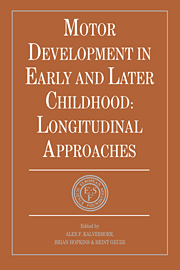Book contents
- Frontmatter
- Contents
- List of contributors
- Foreword
- Preface
- SETTING THE SCENE
- SECTION I BIOLOGICAL BASIS OF MOTOR DEVELOPMENT
- SECTION II DEVELOPMENT OF BODY POSTURE AND GOAL-DIRECTED REACHING
- SECTION III MOTOR DEVELOPMENT, EARLY COMMUNICATION AND COGNITION
- SECTION IV ACQUISITION OF SKILLS
- SECTION V MOTOR DEVELOPMENT AND HANDICAP
- 16 Early motor development in term and preterm children
- 17 Relationship between perinatal risk factors and motor development at the ages of 5 and 9 years
- 18 Motor development and minor handicap
- 19 Longitudinal and cross-sectional approaches in experimental studies in motor development
- SECTION VI METHODOLOGICAL AND CONCEPTUAL CONSIDERATIONS
- Epilogue: description versus explanation
- Index
17 - Relationship between perinatal risk factors and motor development at the ages of 5 and 9 years
from SECTION V - MOTOR DEVELOPMENT AND HANDICAP
Published online by Cambridge University Press: 05 May 2010
- Frontmatter
- Contents
- List of contributors
- Foreword
- Preface
- SETTING THE SCENE
- SECTION I BIOLOGICAL BASIS OF MOTOR DEVELOPMENT
- SECTION II DEVELOPMENT OF BODY POSTURE AND GOAL-DIRECTED REACHING
- SECTION III MOTOR DEVELOPMENT, EARLY COMMUNICATION AND COGNITION
- SECTION IV ACQUISITION OF SKILLS
- SECTION V MOTOR DEVELOPMENT AND HANDICAP
- 16 Early motor development in term and preterm children
- 17 Relationship between perinatal risk factors and motor development at the ages of 5 and 9 years
- 18 Motor development and minor handicap
- 19 Longitudinal and cross-sectional approaches in experimental studies in motor development
- SECTION VI METHODOLOGICAL AND CONCEPTUAL CONSIDERATIONS
- Epilogue: description versus explanation
- Index
Summary
INTRODUCTION
Poor motor performance, usually called clumsiness, has been found in about 5% of children when measured with a set of gross and fine motor tasks (Gubbay, 1975; Henderson & Hall, 1982). Mild neurological dysfunction, implying not only poor performance in motor tasks but also deviations in a thorough neurological examination, has been found in mild form at the age of 9 years in 15% of neonatally normal children (Hadders-Algra, Huisjes & Touwen, 1988a, b). Marked neurological dysfunction was found in 5% of these children.
Clumsiness is often not an isolated problem. It is associated with cognitive, psycholinguistic and learning disabilities (Henderson & Hall, 1982; Lyytinen & Ahonen, 1988; Lindahl, Michelsson & Donner, 1988a; Lindahl et al., 1988b). Abnormalities noted in neurological examinations have similarly been found to be linked with learning disabilities and with poor cognitive and psycholinguistic performance (Younes, Rosner & Webb, 1983; Wolff, Gunnoe & Cohen, 1983; Hadders-Algra et al., 1988a, b). Poor motor performance has been recorded as an essential part in diagnosing the syndrome of minimal brain dysfunction (MBD) (Dunn, 1986; Gillberg et al., 1982).
The aetiological background factors in poor motor function have been the subject of both epidemiological studies and studies concerning various risk groups. In Gothenburg an epidemiological study on the origin of MBD problems indicated that, compared with neonatal, hereditary and rearing factors, a more important part was played by non-optimal prenatal factors (Gillberg & Rasmussen, 1982b; Gillberg et al., 1982).
- Type
- Chapter
- Information
- Motor Development in Early and Later ChildhoodLongitudinal Approaches, pp. 266 - 285Publisher: Cambridge University PressPrint publication year: 1993
- 9
- Cited by



